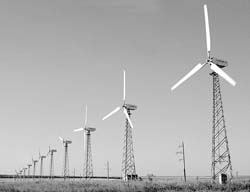Warm dialog
Ukraine and the Netherlands negotiating joint energy-saving efforts
According to the National Agency for the Effective Use of Energy Resources (NAER), Ukraine’s biggest problem in the energy conservation sphere is municipally-controlled heat-and-power engineering, where 20 percent of our country’s key assets are concentrated. How can the effective utilization of these capacities be secured?
This topic was discussed by the participants of the seminar “The Road to Effective and Renewable Energy in the Urban Environment,” where specialists from Ukraine and the Netherlands shared their professional experience. NAER’s second-in-command Hryhorii Makhov emphasized that “a great proportion of urban residents live in high-rise apartment buildings made of precast concrete panels, which were built at a time when unjustifiably low energy prices were combined with demands to speed up construction projects while economizing on building materials: “As a rule, heating systems in these buildings lack any thermal control devices, so energy losses in buildings constructed in the 1920s and 1930s are enormous.”
NAER’s statistics indicate that energy consumption is considerably higher in the residential sector in Central and Eastern European countries than in Western Europe. Makhov said that “the annual general average power-and-heating needs of residential structures in Eastern Europe are estimated at 25-400 kWh per cubic meter, compared to 150-230 in Western European countries. In well-insulated buildings in Scandinavian countries this figure is 120-150 kWh. Moreover, so-called energy-efficient structures that are heated with particular exactness have a yearly consumption rate that does not exceed 60-80 kWh/m? a year.”
According to Makhov, this leads to a situation where nearly one-quarter of the fuel consumed in Ukraine goes to heat residential buildings. Most fuel — over 75% — is spent on keeping central heating and hot water supply systems functioning because municipal equipment’s wear-and-tear rate is almost at 70 percent, leading to a fuel loss of 50 percent: “To a large degree this issue determines national security. Most European countries before joining the EU carried out reforms in their economy and energy sector.”
The Netherlands are preparing to help Ukraine. In April 2006 the Minister of Economic Affairs of the Netherlands and the Minister of Fuel and Energy of Ukraine signed a memorandum of understanding concerning cooperation in the energy sphere. The Dutch minister’s senior advisor H. de Bleek has begun enthusiastically implementing this important document, after arranging for help from the special Dutch agency SenterNovem and his Ukrainian colleagues.
Robert in den Bosch, counsellor at the Economic and Commercial Department of the Embassy of the Kingdom of the Netherlands to Ukraine and Moldova, noted that Ukraine’s energy sector is very attractive to his country: “Ukraine is an important country for the Netherlands. Holland is an important investor for Ukraine.”
Karel Valk, who is in charge of the building program of the Netherlands’ Ministry of Public Housing, Spatial Planning and Environment, described how it is possible to save energy in urban areas and use it more effectively: “In Europe, about 40 percent of energy is consumed by buildings.” He listed such energy-saving options as thermal protection, which means installing double panes for every window, insulating walls, roofs, and floors to prevent drafts; and installing the proper equipment: energy-saving heaters, especially water heaters: “This is ancillary equipment, devices that keep track of your losses and control your expenses, so that you don’t have to open the windows when it’s too hot inside.”
De Bleek also had something to say about energy-saving household appliances: “Guided by ecological planning standards, the EU has formulated minimal energy loss requirements, specifying 30 household appliances, including lighting fixtures, electric motors, television sets, computers, washing machines, refrigerators, etc.” To make the consumer’s life easier, there is a special energy symbol in EU countries, which helps the consumer to distinguish between energy-saving goods and others. “It is also spurring interest in this problem,” adds Valk.
According to de Bleek, the Netherlands have set a course on instituting a tougher energy-saving coefficient for new construction projects. Today it is 0.8, and the Dutch are aiming at 0.4 in 2015 and a zero emission rate in 2020. The same applies to commercial structures. In addition, the Netherlands has introduced a special energy-saving classification of structures and cars. Because a large part of these energy-saving measures have a recoupment period ranging between two and five years, they should be regarded as a rather attractive investment sphere. Also, such energy-saving equipment is tax exempt and building owners can soon expect new financial contributions aimed at supporting the construction of 500,000 structures with energy-saving technology in 2012. Subsidies will also be provided for the installation of solar boilers, heat pumps, and other types of equipment.
Ukraine should borrow this useful experience form the Netherlands, especially now that the Dutch are ready to invest in our energy-saving projects.






